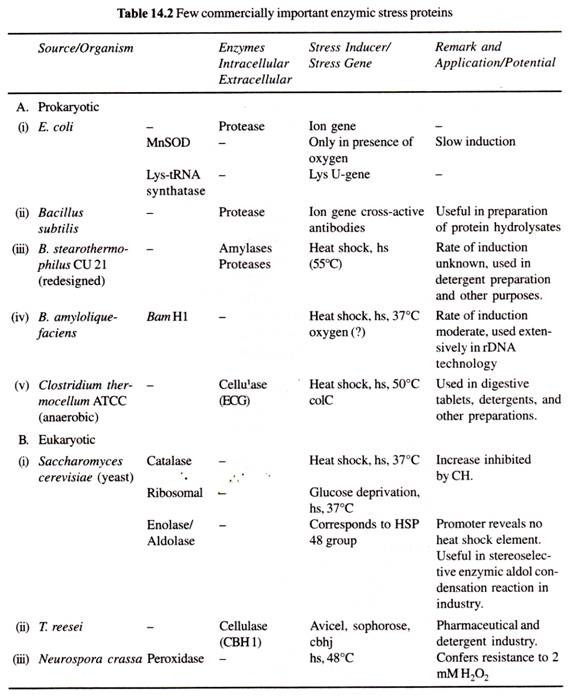ADVERTISEMENTS:
Inducing Agents:
In bio-cells or tissue organs the stress-inducing agents responsible for induction of stress response and abnormal protein formation may be classified as shown in Fig. 14.4.
Chemicals and bio-chemicals are by far the largest stress conditioning agents, although heat shock is the commonly used one.
Micro-flora indigenous to abyssal depths of the deep oceans are believed to be stress induced by barophilicity and psychrophilicity. So they are uniquely adapted for optimal growth at cold temperatures (<40°C) but at elevated hydrostatic pressures (4.00-600 atm) by their environment.
ADVERTISEMENTS:
These micro-flora may, therefore, be considered unique in stress protein synthesis under baroduric conditions. It is, thus, possible to conceive at in vivo stress agents interact and modulate or synergistically effect across functional stress conditioning in de novo protein design. Classical examples of synergistic effects of inducers for the induction of hsp mRNAs in Xenopus kidney epithelial cells and in some other systems are reported in a more recent book.
Thermal stress is well known to be an important physical inducer in HSP formation in both prokaryotes and eukaryotes. In biotechnology for biological scale up of cellular capacity in enhancement of commercial portentous product formation, like enzymes irradiation stressing of cells, has been well practiced for many decades.
Irradiation, therefore, is also a well-known, important non-thermal physical ‘cold shock’ stress protein inducer. The irradiated biological test systems have utilized intact cells or tissue organs. Radiation stress-induced changes in proteins and there in vivo refolding or restructuring are concerned primarily with gross DNA/RNA strand breakage, synthesis of new DNA and RNA and re-establishment of perturbed three-dimensional structure of the DNA macromolecule in association with neighboring RNA, proteins, and lipopolysaccharides.
It has been noticed that the repaired proteinous macromolecule may not function in the same way as before the use of radiation-induced lesions, and mis-folding may arise. It may result in formation of wanted and/or unwanted gene products like proteins in their mother or daughter cells. A list of few enzymes that have been produced using stress agents is given in Table 14.2. Several of them have been used commercially.
Concerns of Inducers:
At molecular level stress inducers have been stated to cause unfolding and breakage of DNA in cells, and E. coli strain was capable of refolding DNA strand breakage (dsb). It has also been demonstrated that single strand break (ssb) repair in bacteria was dependent on different repair enzyme and wild strains of S. typhimurium, however, are not sensitive to O2 and grow. It attributes oxygen sensitivity to damage of SOD by heat.
Antibiotics, like novobiocin and many others, at very low dilution may alter stress protein spectrum by acting as an inhibitor of DNA gyrase enzyme in bacteria exposed to irradiation. It appears, therefore, that heat, chemical, and biological agents may induce changes in stress proteins (SPs) by sensitivity response in cells. Irradiation also effects in the variety of conditions with and without oxygen and with and without irradiation dose modifying agents at different stages of the cell cycle.

